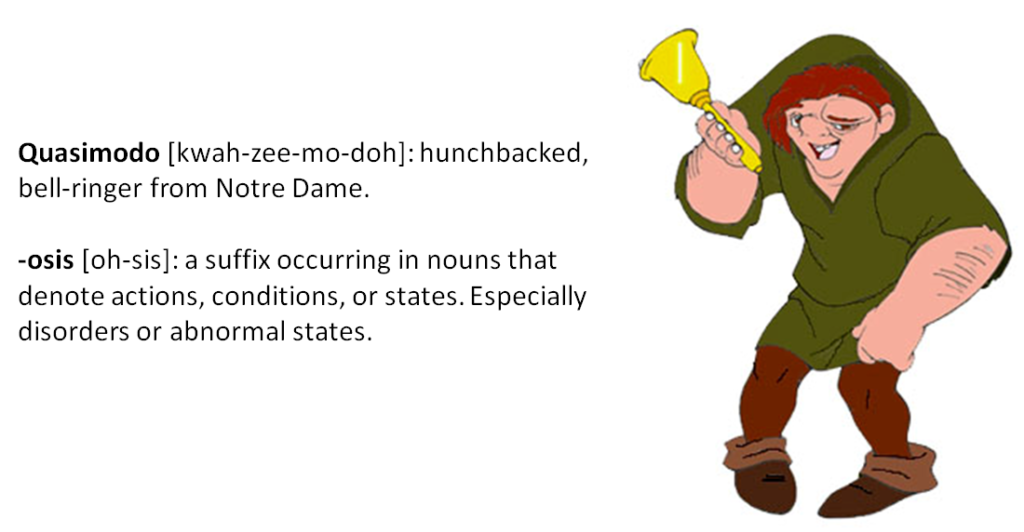I’ll be honest, I’m a bit of a jerk when it comes to picking on my clients’ postures. Well, family and friends are also not immune to my judgmental helpful ways. But I’m not doing it because I hate them and want them to feel bad. I’m just trying to look out for them. You know?
They may not know it, but I can guarantee that 99.9% of them don’t want to end up ringing bells in a clock tower for the rest of their life. The other 0.1%? Well, I don’t really get along with them much anyway. (YOU KNOW WHO YOU ARE.)
But with a myriad of less-than-optimal postures and posture habits to attack in the world, I’ve decided to keep things short and tackle the infamous Quasimodo posture. Or, Quasimodosis, as I like to call it.

If I’ve upset anyone about their career aspirations to become a bell-ringer, please accept my apology. You are welcome to close this page down. No hard feelings. For everyone else, let’s get to it.
Today’s Technological Lifestyle
Today truly is a wonderful time to be alive. The luckiest of us have access to instant hot water, shelter, food, electricity, and clothing. Our level of technology is extraordinary. Though, we are, in some ways, only just starting to utilize the technology that we have. Siri is a prime example of that; including the device she comes on. Quantum mechanics-infused GPS is another, and world-wide communication and access, along with almost limitless information and knowledge up for grabs, highlights the substantial opportunity humans have at this moment in time.
What this technological age means, however, is that our lives are pretty much based around some form of electronic device. Whether it be TV, computers, tablets or our trusty extensions known as the smartphone, the majority of our day involves the use of one or more of these for long periods of time. Sometimes even all day.
This is all good, of course, provided we are aware of length of time, our ergonomic setup, and our posture whilst using. But most of us are not, unfortunately. Or, cannot, for that matter.

Quasimodosis
Give a thought towards the last time you entered a people-filled room with nobody sitting down and staring into their lit-up handheld abyss. I would guess that you probably can’t. But consider the ramifications for this type of posture where one’s shoulders are rounded, their heads are poking forward, and their back is slumped. Habits such as these are all rather common when it comes to Quasimodosis. And unfortunately what this means is that their bodies can begin to become a little sad and angry when this style is prolonged.
For instance, if we are to consistently live a lifestyle of bunched up, less-than-ideal posture, then we will eventually suffer the consequences. We can, however, overcome this kind of scenario. All it takes is a little bit of…
Awareness
This is key to rectifying any postural habits. Although, if we aren’t first made aware of what optimal posture is, then we may fall short on ever becoming truly aware. But as everybody lives different lives, it is indeed difficult to define or determine what “true” posture should be. Take, for instance, the simple comparison between a Cambodian and a Manhattan office worker. What is normal, after all? Two entirely different lifestyles and demands. Despite this, we can still formulate fundamental idealisms.
To do this, we first need to pay attention to the anatomy and physiology of our body. Most notably, joints, joint movement, and autonomic functions such as breathing. If one is to develop Quasimodosis, then these types of functions can become hindered. When this occurs, other areas of the body can suffer. Let me explain further.
If you have the whole hunched package going on (i.e. Quasimodosis), then your lungs may be limited with their ability to expand and collapse. Your diaphragm, too, can lose its ability to ascend and descend. If a situation such as this arises, then obviously breathing patterns can be affected. If and when this occurs, then the body will try to figure out a way to still breathe. To do so, it will most likely adopt some form of compensatory habit.
You have to remember that your body doesn’t really care how it stays alive, as long as it does. So if compensation patterns gets it by, then it will quite happily fallback on these. When it comes to Quasimodosis, however, we can pay attention to a few key areas that always must remain happy.

The diagram above displays the common areas that can be affected by Quasimodosis. Firstly, due to the persistent hunching, the shoulders can begin to lose their range of motion. When this occurs, the body will then have a hard time completing simple movements like reaching for something on a shelf. To counter this, the body will then begin to utilise other (less ideal) areas of the body. Including compensating via the lower back, for example.
Another common area will be the loss of scapulae rib-cage tracking ability and scapulae stability ability. When there is too much restriction going on, the scapulae movement can begin to deteriorate. If and when this occurs, then again, other areas will have to pick up the slack.
You can probably see the trend here. If something loses its typical function or ability, then the body initiates compensation patterns to get by. One major sufferer when it comes to Quasimodosis is the entire thoracic zone, or, the rib-cage zone, as highlighted in the diagram above.
A loss of freedom in this area can lead to all the joints in and around this area losing their ability. Including the breathing scenario I mentioned above. All of this can lead to the entire scenario worsening. Not something that we want happening.
The 5-Question Checklist
But, there’s light at the end of the tunnel. If we begin to pay attention to what a better style of posture is, then we can help feign off any onset of Quasimodosis. To do this, we can follow a simple 5-question checklist such as below.
1. Am I slouching?
2. Am I poking my head forward?
3. When I’m sitting or standing, am I leaning to one side more so than the other?
4. If I’m at my computer, am I reaching too far forward to use the keys/mouse?
5. Am I constantly tight in the lower back, hip flexors, upper traps?
Of course this is a very brief overview of Quasimodosis, and there are certainly more ways to aid in the rectification of it and the hindering of an inevitability towards becoming a bell-ringer. But to learn more about what you can do, please follow the links below to head to other articles where I address similar topics.
Breathing and how it may affect your Quasimodosis
A 3-step protocol for dealing with tightness stimulated by Quasimodosis
Why you need daily servicing to keep Quasimodosis at bay
Ps. I might do a Part 2 for this sometime in the future as I barely scratched the surface of this deep topic. So keep your beady, little eyes peeled for that one.


